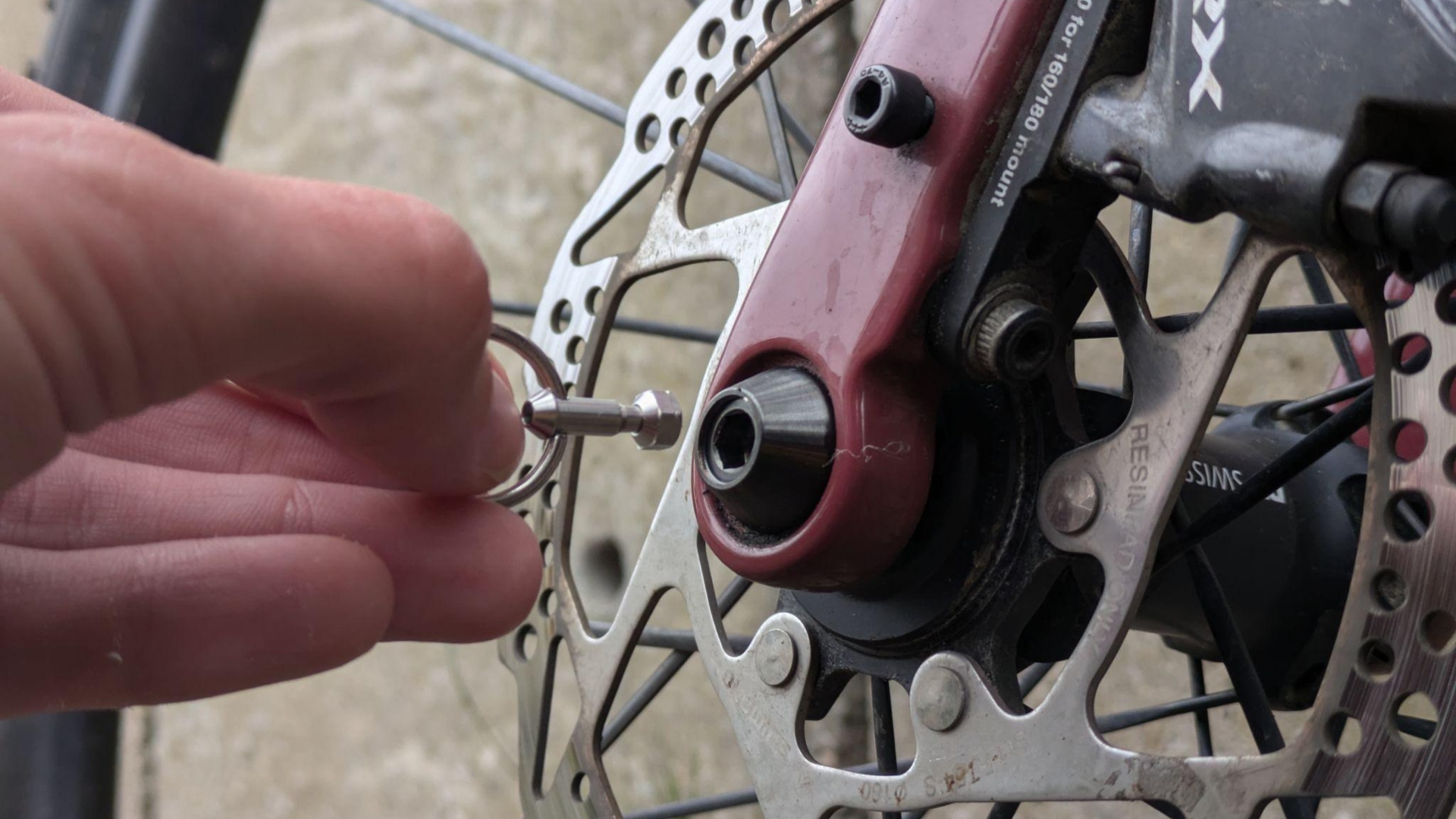Hexlox anti-theft system for wheels review - is the ‘world’s smallest lock for bike parts’ any good?
This bolt blocking solution from Hexlox is tiny and saves you having to lug around a lock cable to go with your D-lock

If you’re a cycle commuter who is looking for a lightweight and discreet solution for protecting your wheels (and other bike parts), then Hexlox’s bolt blocking system is a nifty deterrent against opportunistic bike thieves. It may also slow you down too, if you’re unfortunate enough to get a puncture on your ride in - unless you have the ‘knack’ of removing the Hexlox insert better than I do.
-
+
Discreet
-
+
Lightweight
-
+
Pricey if you need different thru-axles
-
-
Magnets aren’t an infallible anti-theft system
-
-
Can be tricky to remove in a pinch (punctures)
You can trust Cycling Weekly.

If you're commuting to work and leaving your bike unattended in a city, it’s not just your frame that you need to protect. It’s also a sensible idea to lock your wheels, as these are often targeted by thieves too. The classic solution is to loop a cable through your wheels and use one of the best bike locks to secure it, and the frame, to an immovable object. However, this is quite a bulky system.
Self-proclaimed to be the “world’s smallest lock for bike parts”, I was intrigued to test Hexlox’s anti-theft system to see how it works - and find out whether something so tiny can be a reliable system for such an important task.
Construction
If you’re using the Hexlox system for your wheels, it consists of 3 parts: a Hexlox thru-axle for each wheel, a Hexlox key and two Hexlox tiny 6mm stainless steel inserts (which fit into the bolt of each thru-axle).
Importantly, how does Hexlox’s anti-theft system work for securing your wheels? Essentially, you insert the Hexlox into the socket of the thru-axle, which blocks access. If a thief comes along with an Allen key, they simply cannot insert it into the bolt to unscrew the thru-axle - so they’re unable to remove the wheel from your bike.

The HexLox system is simple and weighs next to nothing.
The Hexlox insert can only be removed with your specific Hexlox key as the shape of the Hexlox key and Hexlox insert are matched exactly (and they share the same three-digit keycode which is completely unique to the set).
It’s important to note that the reason why Hexlox inserts stay in the head of the bolt is because they’re magnetic. However, most thru-axles that come standard on your bike are aluminum - meaning that you will likely have to purchase a steel thru axle for the Hexlox insert to work. Hexlox sells a huge range, so you should be able to find one which is compatible with your bike. Or, if you do happen to have a steel thru-axle knocking about, you can just use that.

Hexlox’s system can not only be used on wheels, but also for essentially every bolt on your bike. You can drop the inserts in the bolts for your saddles, seatpost, handlebars, stems, pedals - the list goes on. It’s more likely that at least some of your bolts might be steel (and will therefore work with the magnetic Hexlox inserts), but if not, Hexlox does sell a variety of replacement bolts for different applications, too.
The latest race content, interviews, features, reviews and expert buying guides, direct to your inbox!
I put the system to the test on the thru-axles of my commuting bike. Here’s how it went…
The set up and ride
As mentioned, most thru-axles are aluminium - and mine are no different. In order for Hexlox’s system to work, I first had to swap in front and rear thru-axles which have steel heads. The front is Hexlox branded, the rear was sent by Hexlox, but is actually from Robert Axle.
As both the Hexlox key and insert are magnetic I was able to pick up the tiny insert with my key and place it into the thru-axle. I then turned the key anti-clockwise to lock the insert in place. Really quick and easy to do.
I also like that the key is tiny and much smaller than any other bike lock keys I have. When I added it to my set of house keys I could barely notice that I had added another key.

The installation process is quick and simple
It’s a little trickier to remove the bolt - even with your matching magic magnetic key. I found that I had to really push the key in - and be very precise with removing the insert completely straight (not even at a slight angle). This isn’t the easiest thing to do when you’re crouching by the side of the road on an impromptu stop - most likely when you have a puncture and need to remove your wheel. Luckily I haven’t actually had a puncture on my commuting bike so far this year (thanks to Schwalbe’s excellent G-One Allround tyres), and so the only reason I tried removing the bolt was for the benefit of this test!
Anyway, as the insert is not something you’ll need to remove each day or even each week or month (hopefully), the fact that it’s a little difficult to remove isn’t much of an issue in my opinion.
Given the difficulty and frustration I experienced even removing the insert with the correct key, I’m pretty confident it will a hindrance to thieves. Most are opportunistic, so if they’re trying to jam in their Allen key but find it won't fit, hopefully, they’ll just move on.

The Hexlox system is very discreet but can be fiddly when trying to remove a wheel.
I decided to try to remove the insert with a magnet that I pulled off my fridge door just to see how it’d cope and I wasn’t able to remove the insert. I don’t have any other stronger magnets around to test it with, but Hexlox claims that it’s not possible to remove the insert with a more powerful magnet. It says: “The Hexlox is held in place in your bolt with a very small magnet but the key does not use magnetic force to remove the Hexlox - there is a mechanical bond.” I had no success in using pliers to remove the insert either.
After these tests, I feel confident leaving my bike unattended with just a D-lock and these bolt-blockers. A highly motivated thief might be able to drill out the Hexlox insert using a cordless drill. But I would be surprised at anyone going to that much fiddly effort on the wheels - if the power tools are being broken out, it makes more sense to go straight for the D-Lock.
There are other steps I take to feel good about leaving my bike locked up unattended, such as nearby CCTV and in areas less frequented by thieves. There’s always more you can do to ward off thieves and provide additional protection, but Hexlox seems to be a good balance between security and neatness for me.
I have been impressed by how discreet Hexlox’s solution is. And I’ve also appreciated not having to lug a lock cable around with all my things for work.
In terms of getting set up, it’s quite easy to work out which size Hexlox you need for the bolts on your bike. Simply insert an Allen key into the bolt and whichever size Allen key fits the hole, that’s the size Hexlox you’ll need.
Value and conclusion
A single Hexlox costs £14.00 and Hexlox key costs £14.00, which adds up to £42.00 for protecting your front and rear thru-axles. If you need a front and rear thru-axle to go with it (because your current setup doesn’t have a magnetic steel head) then that’s an extra £54.99 for each. This brings the full cost up to €151.98. This is certainly a steep investment and a considerable amount more than simply using a cable with your D-lock. For example Kryptonite’s Kryptoflex costs just £14.99.

I’ve been hooked on bikes ever since the age of 12 and my first lap of the Hillingdon Cycle Circuit in the bright yellow kit of the Hillingdon Slipstreamers. For a time, my cycling life centred around racing road and track.
But that’s since broadened to include multiday two-wheeled, one-sleeping-bag adventures over whatever terrain I happen to meet - with a two-week bikepacking trip from Budapest into the mountains of Slovakia being just the latest.
I still enjoy lining up on a start line, though, racing the British Gravel Championships and finding myself on the podium at the enduro-style gravel event, Gritfest in 2022.
Height: 177cm
Weight: 60–63kg